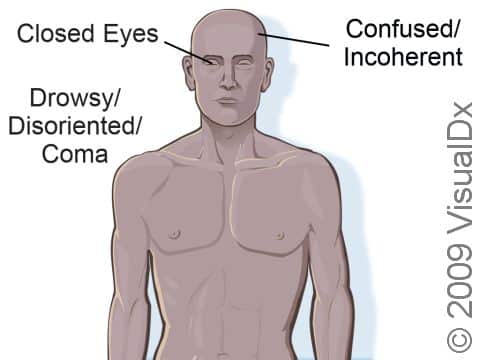Unconsciousness, First Aid
Unconsciousness is an abnormal state unlike sleep in which a person is not alert and not fully responsive to their surroundings. Levels of unconsciousness range from drowsiness to collapse and may range in severity from fainting to coma.
Because an unconscious person cannot cough, clear their throat, or turn their head if in distress, they are in danger of choking, making it very important to keep their airway clear while awaiting medical care.
Who's At Risk?
Unconsciousness can be caused by many types of injuries and illnesses. A common cause of unconsciousness is injury to the head by a fall or blow. Causes of unconsciousness specific to fainting can be found in the Fainting topic.
Diabetes affects blood sugar, and too much sugar (hyperglycemia) or too little sugar (hypoglycemia) can lead to unconsciousness in the form of diabetic coma or insulin shock, respectively.
Substance abuse and alcohol abuse, straining during bowel movement, coughing hard, and breathing quickly (hyperventilating) may all cause unconsciousness.
Signs & Symptoms
A person who is unconscious may be:
- Drowsy and/or disoriented; the person may come in and out of consciousness.
- Confused and incoherent.
- In a coma; the person may be completely motionless.
Self-Care Guidelines
First Aid Guide
If you find an unconscious person, try to determine what caused the loss of consciousness, such as by checking to see if they are wearing a medical alert tag.
You can first attempt to rouse the person by shouting, tapping on their shoulder, and shouting again. If they remain unconscious for more than a couple minutes, call emergency medical services and give general first aid for unconsciousness:
- Check the person’s airway, breathing, and circulation (ABCs).
- If the person vomits or bleeds from their mouth, roll their entire body at one time to the side while protecting their airway. Be sure to support the person’s neck and back to keep the head and body in the same position while you roll them.
- Keep the person from getting cold or overheated, as appropriate, until emergency medical help arrives.
Note: If the person awakens during the above self-care measures and becomes restless or agitated, you may attempt to gently restrain them.
Keep unconscious people safe:
- Do not give an unconscious person anything by mouth, including water; even if they regain consciousness, do not give anything until consulting a medical professional.
- Do not attempt to wake an unconscious person by slapping or shaking them or by using cold water to rouse them.
- Do not put a pillow under the head of an unconscious person because this could block their airway.
Treatments
If the person is not breathing, the medical professional will restore breathing by clearing the airway and resuscitating them.
Loss of consciousness can be caused by many underlying conditions. The medical professional will conduct tests to determine the scope and treat the illness or injury accordingly.
Visit Urgency
If the person does not regain consciousness within a few minutes, contact emergency medical services.
Seek emergency medical care if the person:
- Has stopped breathing.
- Does not regain consciousness quickly (ie, within 5 minutes).
- Has been injured, especially if they are bleeding.
- Has diabetes.
- Is pregnant.
- Is older than 50.
- Is having chest pain, pressure, discomfort, or a pounding or irregular heartbeat.
- Cannot speak, has vision problems, or can’t move their arms or legs.
- Has a seizure.
- Experiences loss of bowel control.
Even if the person does regain consciousness promptly, they should have a medical evaluation to rule out a serious underlying problem.
Trusted Links
Last modified on August 13th, 2024 at 10:58 am

Not sure what to look for?
Try our new Rash and Skin Condition Finder
